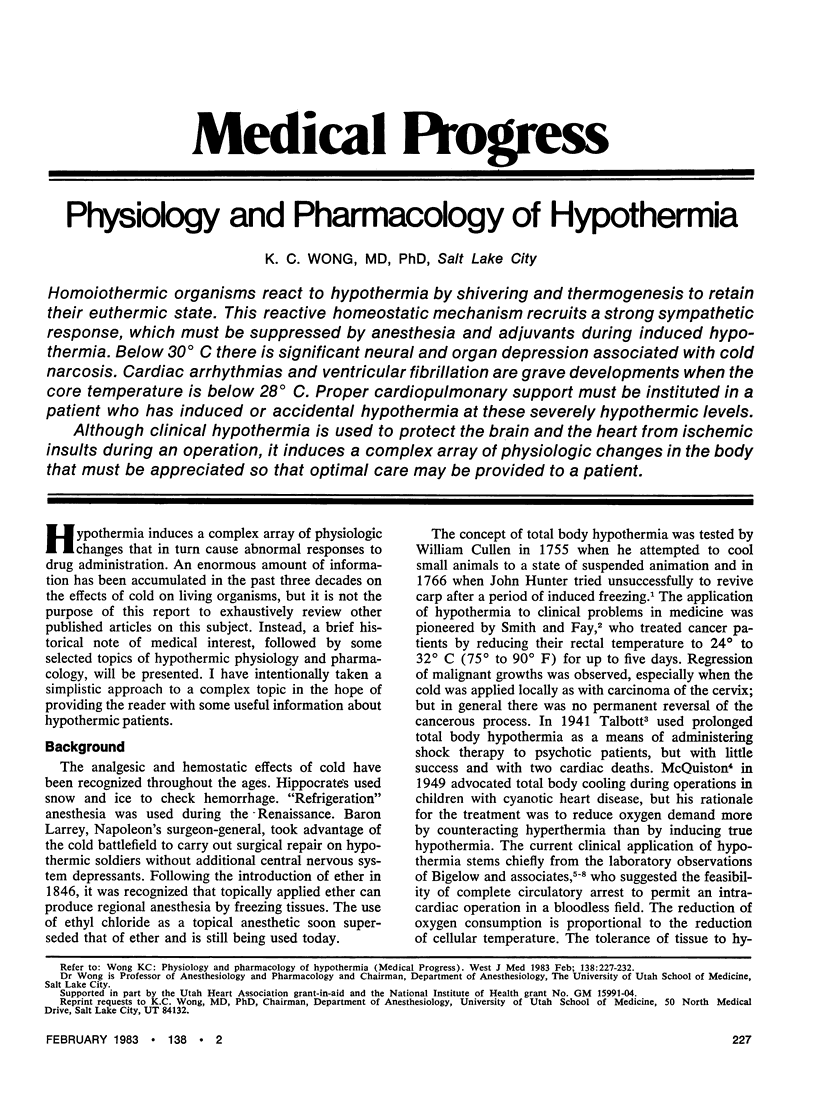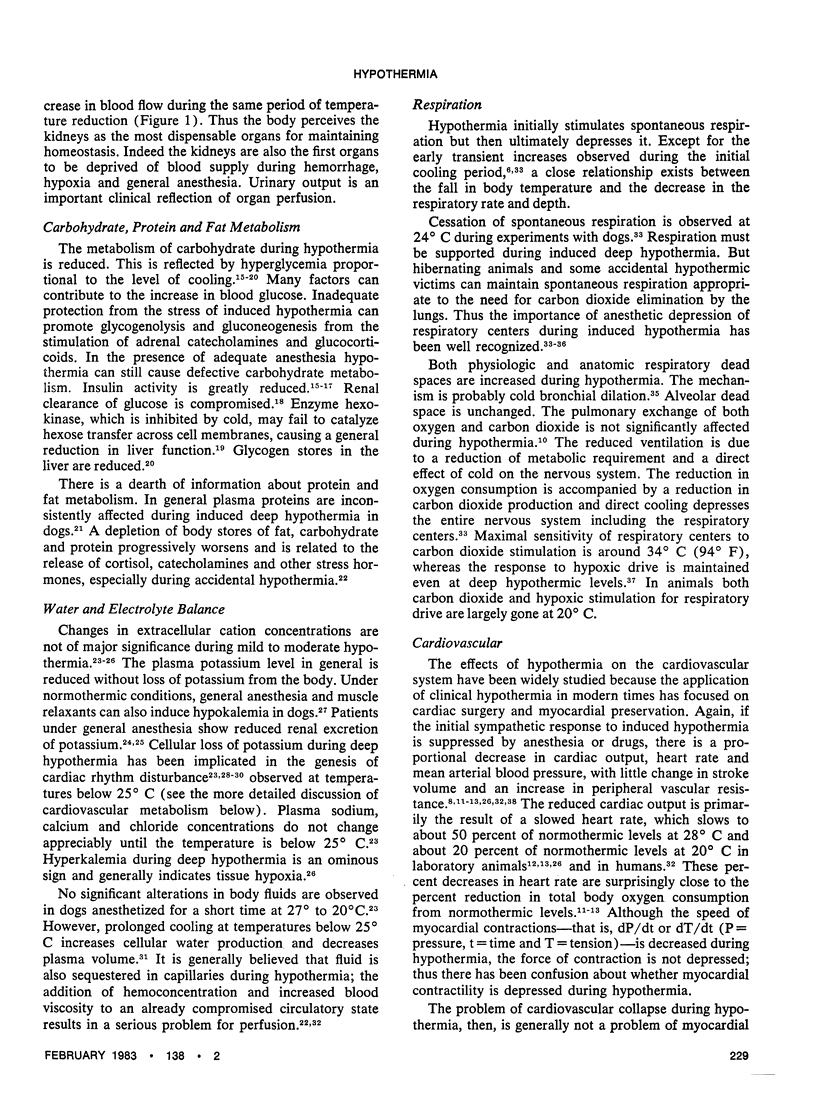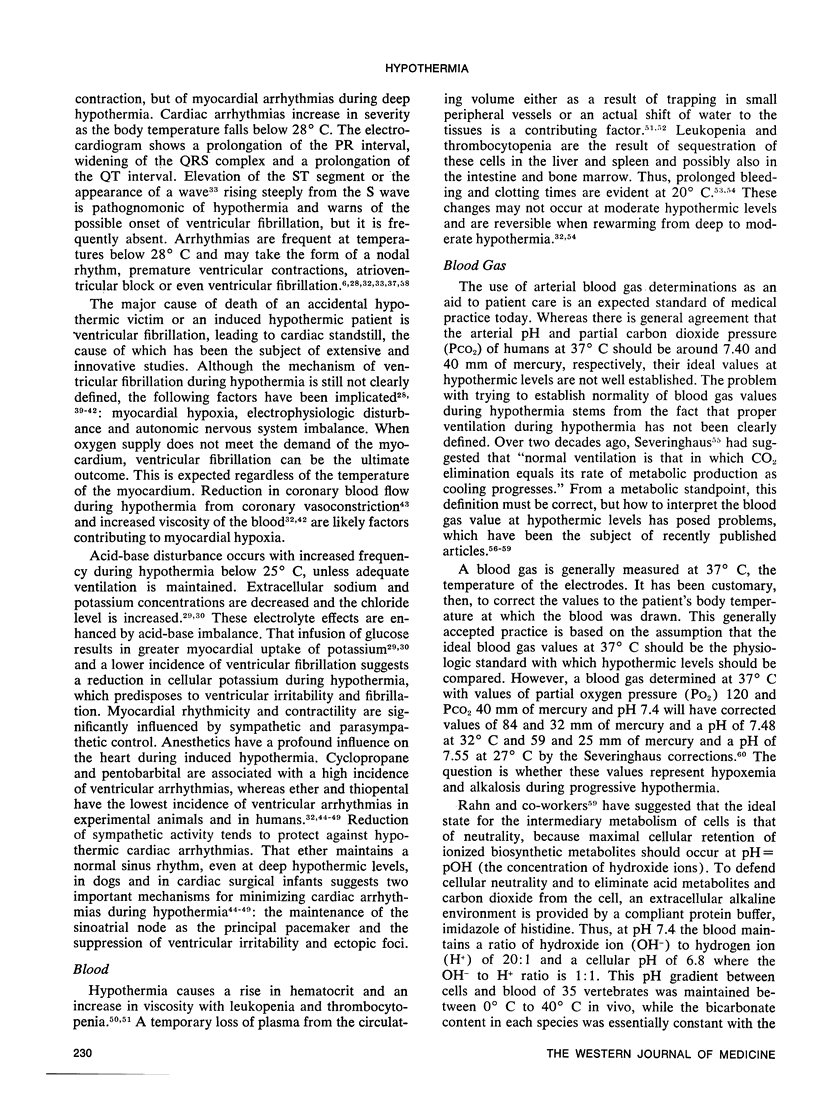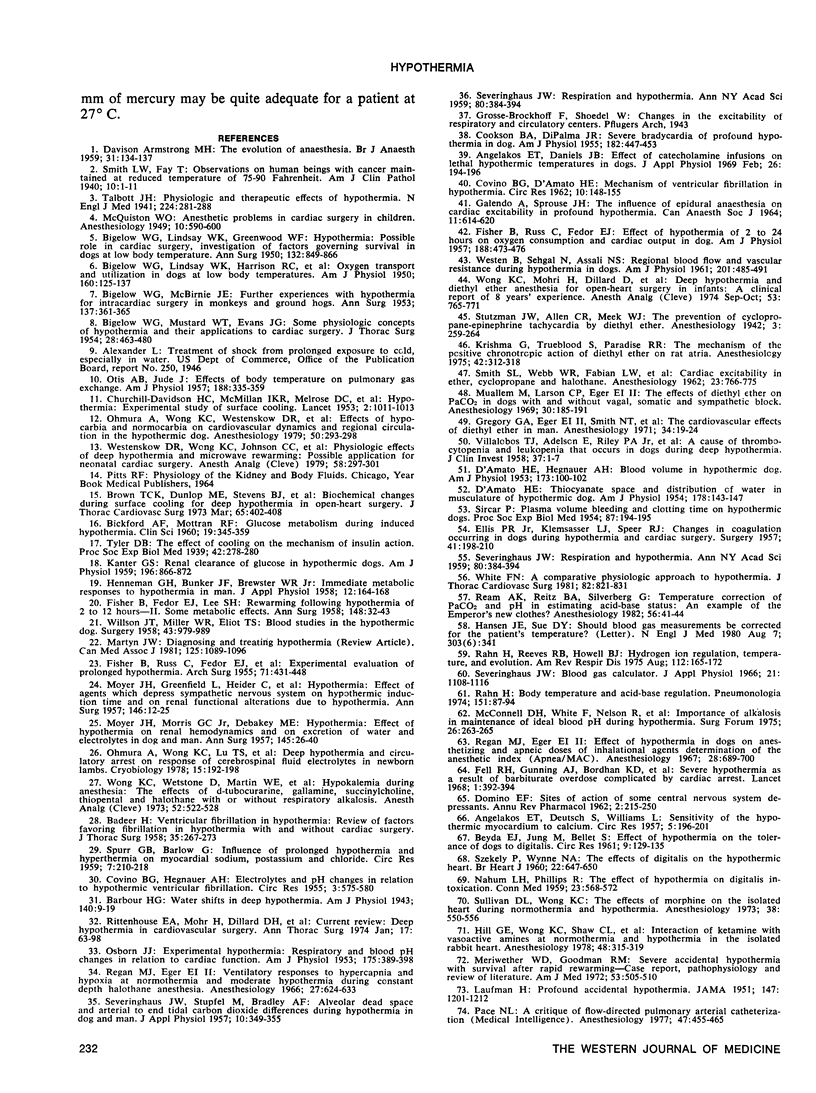Abstract
Homoiothermic organisms react to hypothermia by shivering and thermogenesis to retain their euthermic state. This reactive homeostatic mechanism recruits a strong sympathetic response, which must be suppressed by anesthesia and adjuvants during induced hypothermia. Below 30° C there is significant neural and organ depression associated with cold narcosis. Cardiac arrhythmias and ventricular fibrillation are grave developments when the core temperature is below 28° C. Proper cardiopulmonary support must be instituted in a patient who has induced or accidental hypothermia at these severely hypothermic levels.
Although clinical hypothermia is used to protect the brain and the heart from ischemic insults during an operation, it induces a complex array of physiologic changes in the body that must be appreciated so that optimal care may be provided to a patient.
Full text
PDF





Images in this article
Selected References
These references are in PubMed. This may not be the complete list of references from this article.
- ANGELAKOS E. T., DEUTSCH S., WILLIAMS L. Sensitivity of the hypothermic myocardium to calcium. Circ Res. 1957 Mar;5(2):196–201. doi: 10.1161/01.res.5.2.196. [DOI] [PubMed] [Google Scholar]
- Angelakos E. T., Daniels J. B. Effect of catecholamine infusions on lethal hypothermic temperatures in dogs. J Appl Physiol. 1969 Feb;26(2):194–196. doi: 10.1152/jappl.1969.26.2.194. [DOI] [PubMed] [Google Scholar]
- BADEER H. Ventricular fibrillation in hypothermia; a review of factors favoring fibrillation in hypothermia with and without cardiac surgery. J Thorac Surg. 1958 Feb;35(2):265–273. [PubMed] [Google Scholar]
- BICKFORD A. F., MOTTRAM R. F. Glucose metabolism during induced hypothermia in rabbits. Clin Sci. 1960 May;19:345–359. [PubMed] [Google Scholar]
- BIGELOW W. G., LINDSAY W. K., GREENWOOD W. F. Hypothermia; its possible role in cardiac surgery: an investigation of factors governing survival in dogs at low body temperatures. Ann Surg. 1950 Nov;132(5):849–866. doi: 10.1097/00000658-195011000-00001. [DOI] [PMC free article] [PubMed] [Google Scholar]
- BIGELOW W. G., LINDSAY W. K. Oxygen transport and utilization in dogs at low body temperatures. Am J Physiol. 1950 Jan;160(1):125–137. doi: 10.1152/ajplegacy.1949.160.1.125. [DOI] [PubMed] [Google Scholar]
- BIGELOW W. G., MCBIRNIE J. E. Further experiences with hypothermia for intracardiac surgery in monkeys and groundhogs. Ann Surg. 1953 Mar;137(3):361–365. doi: 10.1097/00000658-195303000-00010. [DOI] [PMC free article] [PubMed] [Google Scholar]
- BIGELOW W. G., MUSTARD W. T., EVANS J. G. Some physiologic concepts of hypothermia and their applications to cardiac surgery. J Thorac Surg. 1954 Nov;28(5):463–480. [PubMed] [Google Scholar]
- Brown T. C., Dunlop M. E., Stevens B. J., Clarke C. P., Shanahan E. A. Biochemical changes during surface cooling for deep hypothermia in open-heart surgery. J Thorac Cardiovasc Surg. 1973 Mar;65(3):402–408. [PubMed] [Google Scholar]
- CHURCHILL-DAVIDSON H. C., McMILLAN I. K., MELROSE D. G., LYNN R. B. Hypothermia: an experimental study of surface cooling. Lancet. 1953 Nov 14;265(6794):1011–1013. doi: 10.1016/s0140-6736(53)91307-5. [DOI] [PubMed] [Google Scholar]
- COOKSON B. A., DI PALMA J. R. Severe bradycardia of profound hypothermia in the dog. Am J Physiol. 1955 Sep;182(3):447–453. doi: 10.1152/ajplegacy.1955.182.3.447. [DOI] [PubMed] [Google Scholar]
- COVINO B. G., D'AMATO H. E. Mechanism of ventricular fibrillation in hypothermia. Circ Res. 1962 Feb;10:148–155. doi: 10.1161/01.res.10.2.148. [DOI] [PubMed] [Google Scholar]
- COVINO B. G., HEGNAUER A. H. Electrolytes and pH changes in relation to hypothermic ventricular fibrillation. Circ Res. 1955 Nov;3(6):575–580. doi: 10.1161/01.res.3.6.575. [DOI] [PubMed] [Google Scholar]
- D'AMATO H. E., HEGNAUER A. H. Blood volume in the hypothermic dog. Am J Physiol. 1953 Apr;173(1):100–102. doi: 10.1152/ajplegacy.1953.173.1.100. [DOI] [PubMed] [Google Scholar]
- D'AMATO H. E. Thiocyanate space and the distribution of water in the musculature of hypothermic dog. Am J Physiol. 1954 Jul;178(1):143–147. doi: 10.1152/ajplegacy.1954.178.1.143. [DOI] [PubMed] [Google Scholar]
- DAVISON M. H. A. The evolution of anaesthesia. Br J Anaesth. 1959 Mar;31(3):134–contd. doi: 10.1093/bja/31.3.134. [DOI] [PubMed] [Google Scholar]
- DEBAKEY M. E., MORRIS G., MOYER J. H. Hypothermia. I. Effect on renal hemodynamics and on excretion of water and electrolytes in dog and man. Ann Surg. 1957 Jan;145(1):26–40. doi: 10.1097/00000658-195701000-00003. [DOI] [PMC free article] [PubMed] [Google Scholar]
- ELLIS P. R., Jr, KLEINSASSER L. J., SPEER R. J. Changes in coagulation occurring in dogs during hypothermia and cardiac surgery. Surgery. 1957 Feb;41(2):198–210. [PubMed] [Google Scholar]
- FISHER B., FEDOR E. J., LEE S. H. Rewarming following hypothermia of two to twelve hours. II. Some metabolic effects. Ann Surg. 1958 Jul;148(1):32–43. doi: 10.1097/00000658-195807000-00003. [DOI] [PMC free article] [PubMed] [Google Scholar]
- FISHER B., RUSS C., FEDOR E. J. Effect of hypothermia of 2 to 24 hours on oxygen consumption and cardiac output in the dog. Am J Physiol. 1957 Mar;188(3):473–476. doi: 10.1152/ajplegacy.1957.188.3.473. [DOI] [PubMed] [Google Scholar]
- FISHER B., RUSS C., FEDOR E., WILDE R., ENGSTROM P., HAPPEL J., PRENDERGAST P. Experimental evaluation of prolonged hypothermia. AMA Arch Surg. 1955 Sep;71(3):431–448. doi: 10.1001/archsurg.1955.01270150125015. [DOI] [PubMed] [Google Scholar]
- Fell R. H., Gunning A. J., Bardhan K. D., Triger D. R. Severe hypothermia as a result of barbiturate overdose complicated by cardiac arrest. Lancet. 1968 Feb 24;1(7539):392–394. doi: 10.1016/s0140-6736(68)91357-3. [DOI] [PubMed] [Google Scholar]
- GALINDO A., SPROUSE J. H. THE INFLUENCE OF EPIDURAL ANAESTHESIA ON CARDIAC EXCITABILITY IN PROFOUND HYPOTHERMIA. Can Anaesth Soc J. 1964 Nov;11:614–620. doi: 10.1007/BF03004106. [DOI] [PubMed] [Google Scholar]
- Gregory G. A., Eger E. I., 2nd, Smith N. T., Cullen B. F., Cullen D. J. The cardiovascular effects of diethyl ether in man. Anesthesiology. 1971 Jan;34(1):19–24. doi: 10.1097/00000542-197101000-00009. [DOI] [PubMed] [Google Scholar]
- HENNEMAN D. H., BUNKER J. P., BREWSTER W. R., Jr Immediate metabolic response to hypothermia in man. J Appl Physiol. 1958 Mar;12(2):164–168. doi: 10.1152/jappl.1958.12.2.164. [DOI] [PubMed] [Google Scholar]
- Hansen J. E., Sue D. Y. Should blood gas measurement be corrected for the patient's temperature? N Engl J Med. 1980 Aug 7;303(6):341–341. doi: 10.1056/nejm198008073030616. [DOI] [PubMed] [Google Scholar]
- Hill G. E., Wong K. C., Shaw C. L., Sentker C. R., Blatnick R. A. Interactions of ketamine with vasoactive amines at normothermia and hypothermia in the isolated rabbit heart. Anesthesiology. 1978 May;48(5):315–319. doi: 10.1097/00000542-197805000-00003. [DOI] [PubMed] [Google Scholar]
- KANTER G. S. Renal clearance of glucose in hypothermic dogs. Am J Physiol. 1959 Apr;196(4):866–872. doi: 10.1152/ajplegacy.1959.196.4.866. [DOI] [PubMed] [Google Scholar]
- Krishna G., Trueblood S., Paradise R. R. The mechanism of the positive chronotropic action of diethyl ether on rat atria. Anesthesiology. 1975 Mar;42(3):312–318. doi: 10.1097/00000542-197503000-00014. [DOI] [PubMed] [Google Scholar]
- LAUFMAN H. Profound accidental hypothermia. J Am Med Assoc. 1951 Nov 24;147(13):1201–1212. doi: 10.1001/jama.1951.03670300015004. [DOI] [PubMed] [Google Scholar]
- MOYER J. H., GREENFIELD L., HEIDER C., HANDLEY C. Hypothermia. II. The effect of agents which depress the sympathetic nervous system on the hypothermic induction time and on renal functional alterations due to hypothermia. Ann Surg. 1957 Jul;146(1):12–25. doi: 10.1097/00000658-195707000-00003. [DOI] [PMC free article] [PubMed] [Google Scholar]
- Martyn J. W. Diagnosing and treating hypothermia. Can Med Assoc J. 1981 Nov 15;125(10):1089–1096. [PMC free article] [PubMed] [Google Scholar]
- McConnell D. H., White F., Nelson R. L., Goldstein S. M., Maloney J. V., Jr, DeLand E. C., Buckberg G. D. Importance of alkalosis in maintenance of "ideal" blood pH during hypothermia. Surg Forum. 1975;26:263–265. [PubMed] [Google Scholar]
- Meriwether W. D., Goodman R. M. Severe accidental hypothermia with survival after rapid rewarming. Case report, pathophysiology and review of the literature. Am J Med. 1972 Oct;53(4):505–510. doi: 10.1016/0002-9343(72)90146-5. [DOI] [PubMed] [Google Scholar]
- Muallem M., Larson C. P., Jr, Eger E. I., 2nd The effects of diethyl ether on PaCO2 in dogs with and without vagal, somatic and sympathetic block. Anesthesiology. 1969 Feb;30(2):185–191. doi: 10.1097/00000542-196902000-00015. [DOI] [PubMed] [Google Scholar]
- NAHUM L. H., PHILLIPS R. The effect of hypothermia on digitalis intoxication. Conn Med. 1959 Sep;23:568–572. [PubMed] [Google Scholar]
- OSBORN J. J. Experimental hypothermia; respiratory and blood pH changes in relation to cardiac function. Am J Physiol. 1953 Dec;175(3):389–398. doi: 10.1152/ajplegacy.1953.175.3.389. [DOI] [PubMed] [Google Scholar]
- OTIS A. B., JUDE J. Effect of body temperature on pulmonary gas exchange. Am J Physiol. 1957 Feb;188(2):355–359. doi: 10.1152/ajplegacy.1957.188.2.355. [DOI] [PubMed] [Google Scholar]
- Ohmura A., Wong K. C., Lu T. S., Rutterberg H., Chang R. Deep hypothermia and circulatory arrest: effect on cerebrospinal fluid electrolytes in newborn lambs. Cryobiology. 1978 Apr;15(2):192–198. doi: 10.1016/0011-2240(78)90023-8. [DOI] [PubMed] [Google Scholar]
- Ohmura A., Wong K. C., Westenskow D. R., Shaw C. L. Effects of hypocarbia and normocarbia on cardiovascular dynamics and regional circulation in the hypothermic dog. Anesthesiology. 1979 Apr;50(4):293–298. doi: 10.1097/00000542-197904000-00003. [DOI] [PubMed] [Google Scholar]
- Pace N. L. A critique of flow-directed pulmonary arterial catheterization. Anesthesiology. 1977 Nov;47(5):455–465. doi: 10.1097/00000542-197711000-00014. [DOI] [PubMed] [Google Scholar]
- Rahn H. Body temperature and acid-base regulation. (Review article). Pneumonologie. 1974;151(2):87–94. doi: 10.1007/BF02097155. [DOI] [PubMed] [Google Scholar]
- Rahn H., Reeves R. B., Howell B. J. Hydrogen ion regulation, temperature, and evolution. Am Rev Respir Dis. 1975 Aug;112(2):165–172. doi: 10.1164/arrd.1975.112.2.165. [DOI] [PubMed] [Google Scholar]
- Ream A. K., Reitz B. A., Silverberg G. Temperature correction of PCO2 and pH in estimating acid-base status: an example of the emperor's new clothes? Anesthesiology. 1982 Jan;56(1):41–44. doi: 10.1097/00000542-198201000-00009. [DOI] [PubMed] [Google Scholar]
- Regan M. J., Eger E. I., 2nd Effect of hypothermia in dogs on anesthetizing and apneic doses of inhalation agents. Determination of the anesthetic index (Apnea/MAC). Anesthesiology. 1967 Jul-Aug;28(4):689–700. doi: 10.1097/00000542-196707000-00015. [DOI] [PubMed] [Google Scholar]
- Regan M. J., Eger E. I., 2nd Ventilatory responses to hypercapnia and hypoxia at normothermia and moderate hypothermia during constant-depth halothane anesthesia. Anesthesiology. 1966 Sep-Oct;27(5):624–633. doi: 10.1097/00000542-196609000-00013. [DOI] [PubMed] [Google Scholar]
- Rittenhouse E. A., Mori H., Dillard D. H., Merendino K. A. Deep hypothermia in cardiovascular surgery. Ann Thorac Surg. 1974 Jan;17(1):63–98. doi: 10.1016/s0003-4975(10)65062-x. [DOI] [PubMed] [Google Scholar]
- SEVERINGHAUS J. W. Respiration and hypothermia. Ann N Y Acad Sci. 1959 Sep 14;80:384–394. doi: 10.1111/j.1749-6632.1959.tb49218.x. [DOI] [PubMed] [Google Scholar]
- SEVERINGHAUS J. W. Respiration and hypothermia. Ann N Y Acad Sci. 1959 Sep 14;80:384–394. doi: 10.1111/j.1749-6632.1959.tb49218.x. [DOI] [PubMed] [Google Scholar]
- SEVERINGHAUS J. W., STUPFEL M. A., BRADLEY A. F. Alveolar dead space and arterial to end-tidal carbon dioxide differences during hypothermia in dog and man. J Appl Physiol. 1957 May;10(3):349–355. doi: 10.1152/jappl.1957.10.3.349. [DOI] [PubMed] [Google Scholar]
- SIRCAR P. Plasma volume, bleeding and clotting time on hypothermic dogs. Proc Soc Exp Biol Med. 1954 Oct;87(1):194–195. doi: 10.3181/00379727-87-21331. [DOI] [PubMed] [Google Scholar]
- SMITH S. L., WEBB W. R., FABIAN L. W., HAGAMAN V. D. Cardiac excitability in ether, cyclopropane and halothane anesthesia. Anesthesiology. 1962 Nov-Dec;23:766–775. doi: 10.1097/00000542-196211000-00006. [DOI] [PubMed] [Google Scholar]
- SPURR G. B., BARLOW G. Influence of prolonged hypothermia and hyperthermia on myocardial sodium, potassium and chloride. Circ Res. 1959 Mar;7(2):210–218. doi: 10.1161/01.res.7.2.210. [DOI] [PubMed] [Google Scholar]
- SZEKELY P., WYNNE N. A. The effects of digitalis on the hypothermic heart. Br Heart J. 1960 Nov;22:647–650. doi: 10.1136/hrt.22.5.647. [DOI] [PMC free article] [PubMed] [Google Scholar]
- Severinghaus J. W. Blood gas calculator. J Appl Physiol. 1966 May;21(3):1108–1116. doi: 10.1152/jappl.1966.21.3.1108. [DOI] [PubMed] [Google Scholar]
- Sullivan D. L., Wong K. C. The effects of morphine on the isolated heart during normothermia and hypothermia. Anesthesiology. 1973 Jun;38(6):550–556. doi: 10.1097/00000542-197306000-00009. [DOI] [PubMed] [Google Scholar]
- VILLALOBOS T. J., ADELSON E., RILEY P. A., Jr, CROSBY W. H. A cause of the thrombocytopenia and leukopenia that occur in dogs during deep hypothermia. J Clin Invest. 1958 Jan;37(1):1–7. doi: 10.1172/JCI103576. [DOI] [PMC free article] [PubMed] [Google Scholar]
- WESTIN B., SEHGAL N., ASSALI N. S. Regional blood flow and vascular resistance during hypothermia in dog. Am J Physiol. 1961 Sep;201:485–491. doi: 10.1152/ajplegacy.1961.201.3.485. [DOI] [PubMed] [Google Scholar]
- WILLSON J. T., MILLER W. R., ELIOT T. S. Blood studies in the hypothermic dog. Surgery. 1958 Jun;43(6):979–989. [PubMed] [Google Scholar]
- Westenskow D. R., Wong K. C., Johnson C. C., Wilde C. S. Physiologic effects of deep hypothermia and microwave rewarming: possible application for neonatal cardiac surgery. Anesth Analg. 1979 Jul-Aug;58(4):297–301. doi: 10.1213/00000539-197907000-00007. [DOI] [PubMed] [Google Scholar]
- White F. N. A comparative physiological approach to hypothermia. J Thorac Cardiovasc Surg. 1981 Dec;82(6):821–831. [PubMed] [Google Scholar]
- Wong K. C., Mohri H., Dillard D., Martin W., Amory D., Cheney F., Jr, Merendino K. A. Deep hypothermia and diethyl ether anesthesia for open-heart surgery in infants: a clinical report of 8 years' experience. Anesth Analg. 1974 Sep-Oct;53(5):765–771. [PubMed] [Google Scholar]
- Wong K. C., Wetstone D., Martin W. E., Cheney F., Wyte S. R. Hypokalemia during anesthesia: the effects of d-tubocurarine, gallamine, succinylcholine, thiopental, and halothane with or without respiratory alkalosis. Anesth Analg. 1973 Jul-Aug;52(4):522–528. [PubMed] [Google Scholar]



